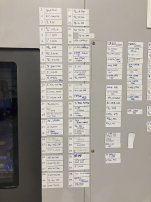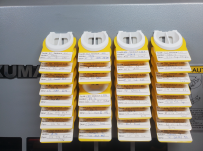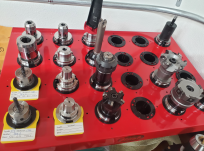joeymorgans
Plastic
- Joined
- Nov 20, 2021
Just got a new Mazak CV5-500 5-axis CNC machine with a 30 ATC. I work in a job shop environment working with mostly aluminium, plastic, mild steel, stainless steel. There is a small chance of doing occasional brass, and superalloys. Components are small to medium sized. I would love to hear your thoughts on how I should decide on my standard tooling.
I want as few tools as possible in order to reduce set up time!
So far I am thinking of splitting up my tooling into the following categories below. I will keep all of these tools set up in holders, either inside the machine or in storage. Then just swap them out when required.
Aluminium / Plastics:
-End mills - standard length - roughing and finishing with same tool - 3 flute - sharp corner - for slotting and HEM.
-End mills - long length rib (reduced neck) - roughing and finishing with same tool - 3 flute - sharp corner - for slotting and HEM.
-Ball nose end mills - roughing and finishing with the same tool - 3 flute.
-Barrell mills - finishing.
-Spiral flute cut taps - M3-M12 - aluminium specific taps.
-Face mills / tipped end mills - 90 degree.
Steels / Stainless Steels:
-End mills - standard length - roughing - 4 flute - 0.5mm radius - for slotting and HEM.
-End mills - standard length - finishing - 6 flute - sharp corner - for better rigidity and higher feed rates.
-Ball nose end mills - roughing and finishing with the same tool.
-Spiral flute cut taps - M3-M12 - specific for steels / stainless (will they break?)
-Face mills - high feed.
General purpose (all materials):
-Thread mills (for doing plate work so you don't have to tap so far into your sacrificial plate).
-Corner rounding tools.
-Carbide TSC drills 5 x D - all sizes required for metric threads M3-M12, and clearance holes.
-Chamfer mills.
-Back side chamfer mills.
Obviously this won't cover everything, but I'm hoping I can do 90% of jobs with only these tools, and just add some special tool where needed.
Let me know if you think anything is missing, if I should split my materials differently, or if you think I should add a bigger range of tools.
Thanks!
Joe
I want as few tools as possible in order to reduce set up time!
So far I am thinking of splitting up my tooling into the following categories below. I will keep all of these tools set up in holders, either inside the machine or in storage. Then just swap them out when required.
Aluminium / Plastics:
-End mills - standard length - roughing and finishing with same tool - 3 flute - sharp corner - for slotting and HEM.
-End mills - long length rib (reduced neck) - roughing and finishing with same tool - 3 flute - sharp corner - for slotting and HEM.
-Ball nose end mills - roughing and finishing with the same tool - 3 flute.
-Barrell mills - finishing.
-Spiral flute cut taps - M3-M12 - aluminium specific taps.
-Face mills / tipped end mills - 90 degree.
Steels / Stainless Steels:
-End mills - standard length - roughing - 4 flute - 0.5mm radius - for slotting and HEM.
-End mills - standard length - finishing - 6 flute - sharp corner - for better rigidity and higher feed rates.
-Ball nose end mills - roughing and finishing with the same tool.
-Spiral flute cut taps - M3-M12 - specific for steels / stainless (will they break?)
-Face mills - high feed.
General purpose (all materials):
-Thread mills (for doing plate work so you don't have to tap so far into your sacrificial plate).
-Corner rounding tools.
-Carbide TSC drills 5 x D - all sizes required for metric threads M3-M12, and clearance holes.
-Chamfer mills.
-Back side chamfer mills.
Obviously this won't cover everything, but I'm hoping I can do 90% of jobs with only these tools, and just add some special tool where needed.
Let me know if you think anything is missing, if I should split my materials differently, or if you think I should add a bigger range of tools.
Thanks!
Joe






